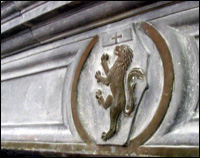|
“All the history of Piobbico is inside the castle,”
said Sante Fini, a tour guide for the palace and the author
of the Brancaleoni Family Castle and Piobbico guidebook.
“The beginning of Piobbico started there.”
The original castle was built in the 11th century, but the
Brancaleoni family built the existing castle during the 14th
century. Specific dates are still a mystery, Fini said.
“The Brancaleoni family were travelers, and they built
the first family castle on the first mountain in Piobbico,”
said Fini. “But due to the weather they could not travel
to the mountain, and they made the current Brancaleoni castle
their home.”
The Brancaleoni family was very close friends with the German
King Federico Barbarossa, who controlled nearby Cagli and
other towns in Italy. Barbarossa gave the family — Antonio
I, his wife Victoria, eight sons and one daughter —
the land in Piobbico as a gift in return for their hospitality
and friendship.
There are only two doors into the entire palace. The castle,
which contains more than 130 rooms, was built with stones
from nearby mountains. Within the castle was once a small
village, known as a borgo, which housed all the Brancaleoni
servants and employees.
A typical house in the Brancaleoni castle was entered through
a small wooden door that is no more than two feet six inches
wide. The symbol of Nicolosa — a stone carving with
three faces representing the present, past and future —
hangs above many of those doors.
Fini explained that the clock tower, built in 1510, is very
unusual as there are only two of its kind in all of Italy.
The clock ran counterclockwise and displayed Roman numerals,
rather than numbers.
The courtyard consists of an open garden surrounded by pillars,
doors and windows to many rooms.
“This is the most interesting and beautiful part of
the castle,” Fini said.
Each door and window had the name and date of the person
who made it carved in stone above it.
|
 |
The
Brancaleoni symbol |
"All
the history of Piobbico is in the castle," said Sante
Fini.... "The beginning
of Piobbico started there."
“The family lived in the castle until 1860 or 1870,
but it is not certain,” said Fini, a retired elementary
school teacher and native of Piobbico.
As the age of feudalism passed, the Brancaleoni’s castle
was taken over by the state.
“You will see that the Brancaleoni family had everything
taken from them, and it wasn’t a pretty sight before
restoration,” said Fini.
Renovations to the castle began in the 1970s and continue
today.
The Brancaleoni family has thousands of descendants. Now,
over 1000 years after the family established their home in
Piobbico, members of the Brancaleoni family continue on their
travels.
“There are Brancaleonis everywhere,” said Fini,
“in Pesaro, Fano, Rome and all over the world.”
|

